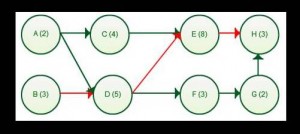
The Critical Path Method, or CPM, is the analysis of a project schedule to determine which tasks are on the critical path, and which are out of it. It is a means of determining important steps to ensure timely completion of the project.
Successful completion on time is the result of identifying the correct critical path. Therefore, the quality of the critical path analysis influences the schedule and its final cost.
CPM scheduling is a widely practiced technique across organizations ranging from small businesses, computer manufacturing, construction and aerospace management to defense material production. The schedule is designed to recognize progress of the project achieved or not achieved by the end date. The CPM timeline gives managers an idea whether to schedule additional tasks or reschedule the existing ones to ward off delays.
The critical path identified in the chart shows managers the activities that are more time-consuming in the project. This allows them to focus on improvements of those tasks and enable acceleration if needed for the timely completion of that project. There are a few things for the project managers to consider and analyze before initiating their CPM based project. Let’s have a look.
- Time duration of the project
- Allotted budgetary figure for project completion
- Project Team / Human resources sanctioned
- A list of tasks / activities required to finish the project
- A CPM chart with clearly marked critical path
Designing a chart with all these requirements clearly mentioned is the primary task on hand for the project planners or managers. What they do is to use the list of activities with timeframe in mind and chalk out a tentative schedule of the project beginning with start date and ending with the project completion date. The project manager has to take into account various factors in designing the CPM chart, which looks something like this:

The encircled alphabets here represent the tasks/activities in the order they are needed to complete by certain dates (mentioned in brackets). The most important ones lie separately in a path awaiting completion on or before their stipulated schedule. Each activity from this path therefore is assigned an earliest and latest start time and end time. The line joining these critical activities is the critical path of the project.
All the activities belonging to this path are executed on time on priority basis so that the project finishes on or before the end date. That helps to control the budget allotted for the project. Even a slight delay in any of critical activities disturbs the end date of the project and delays it beyond control. Obviously, the cost would also balloon up making the project rather unnecessarily expensive.
The project managers therefore are quite sensitive to this critical path. The activities outside this path however aren’t time sensitive. Delay in their completion doesn’t affect the end date of the project. Hence, these activities are called slack or float and are executed parallel to the critical path with flexible time limit.
This time onwards, the critical path analysis becomes a mandatory kind of thing for the project managers. Sometimes the work is affected by unforeseen circumstances. That may result in the delay of the related activity lying in the critical path. In that case, the entire schedule gets disturbed and yields the possibility of delaying the project. Sometimes, project manager may come across situations, which forces him to reassess the schedule or reschedule the entire CPM.
To counter these problems, the project manager either has to accelerate the remaining tasks or employ additional resources to make up the lost time. The CPM chart is then updated daily. The project analysis of such a CPM implemented activities is, therefore, done regularly to monitor changes and add time risk factor of time by 20% in the schedule.
